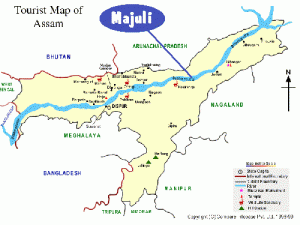The Guinness World Records has declared Majuli in Assam as the largest river island in the world. The beautiful river island is situated on the Brahmaputra River. It has toppled Marajo in Brazil to clinch the record.
About Majuli :
Mājuli or Majoli is the world biggest river island in the world in the Brahmaputra River, Assam, India. The island had a total area of 1,250 square kilometres at the beginning of the 20th century, but having lost significantly to erosion it had an area of only 352 square kilometres in 2014.
- Originally, the island was a long, narrow piece of land called Majoli that had the
 Brahmaputra flowing in the north and the Burhidihing flowing in the south, till they met at Lakhu.
Brahmaputra flowing in the north and the Burhidihing flowing in the south, till they met at Lakhu. - Majuli has shrunk as the river surrounding it has grown.However it is recognized by Guinness Book of World Records as World’s Largest River Island
- The island is formed by theBrahmaputra river in the south and the Kherkutia Xuti, an anabranch of the Brahmaputra, joined by the Subansiri River in the north. Mājuli island is accessible by ferries from the city of Jorhat.
- The island is about 200 kim east from the state’s largest city —Guwahati. It was formed due to course changes by the river Brahmaputra and its tributaries, mainly the Lohit. Mājuli is the abode of the Assamese neo-Vaisnavite culture.
- The main industry is agriculture, with paddy being the chief crop. Mājuli has a rich and diverse agricultural tradition, with as many as 100 varieties of rice grown, all without pesticides or artificial fertilisers.
- Among the fascinating arrays of rice produced are the Komal Saul, a unique type that can be eaten after immersing the grains in warm water for 15 minutes and usually eaten as a breakfast cereal; the bao dhan, that grows under water and is harvested after ten months; and the Bora saul, a sticky brown rice used to make the traditional cake known as pitha. Fishing, dairying, pottery, handloom and boat-making are other important economic activities.
- Handloom is a major occupation among the distaff population of the villages. Although largely a non-commercial occupation, it keeps many of the inhabitants occupied. Weaving is exquisite and intricate with the use of a variety of colours and textures ofcotton and silk, especially Muga silk.
- Mājuli has been the cultural capital of Assamese civilisation since the 16th century; based on written records describing the visit of Srimanta Sankardeva — a 16th-century social reformer.
- Sankardeva, a pioneer of the medieval-age neo-Vaishnavite movement, preached a monotheist form of Hinduism called Vaishnavism and established monasteries and hermitages known as satra on the islet.
- The island soon became the leading center of Vaishavinism with the establishment of these satras. After the arrival of the British, Majuli was under the rule of the British until India gained independence in 1947. It is one of world’s biggest river islands.
- Languages spoken are Mising, Assamese, and Deori. The island has 144 villages with a population of over 160,000 and a density of 300 individuals per square km. Assam Chief Minister Sarbananda Sonowal had contested the 2016 Assembly election from Majuli.
The island has been nominated to be a UNESCO World Heritage Site. The nomination has not been approved yet. The wetland attracts many different kinds of fauna and varied kind of fauna also grows on the island.
AffairsCloud Recommends Oliveboard Mock Test
AffairsCloud Ebook - Support Us to Grow
Govt Jobs by Category
Bank Jobs Notification



 Brahmaputra flowing in the north and the Burhidihing flowing in the south, till they met at Lakhu.
Brahmaputra flowing in the north and the Burhidihing flowing in the south, till they met at Lakhu.

